A new kind of tourism is catching on in recent years: visiting Monumental Cemeteries, ancient burial grounds where time is suspended and one breathes tranquility, silence and peace.
Italy, being a country of art and history par excellence, offers Monumental Cemeteries worth visiting, in which it is possible to admire important funerary sculptures, tombs and noble chapels or humble and anonymous tombstones, where prominent people who have made history rest.
Without being frightened by beliefs or superstitions, we at VisitItaly take you on a journey to discover 10 of Italy’s most evocative Monumental Cemeteries, from the largest in Milan, Genoa, and Rome, to the smaller yet equally fascinating ones in Brescia, Venice, Bologna, and Naples.

Burial from Origins to Monumental Cemeteries
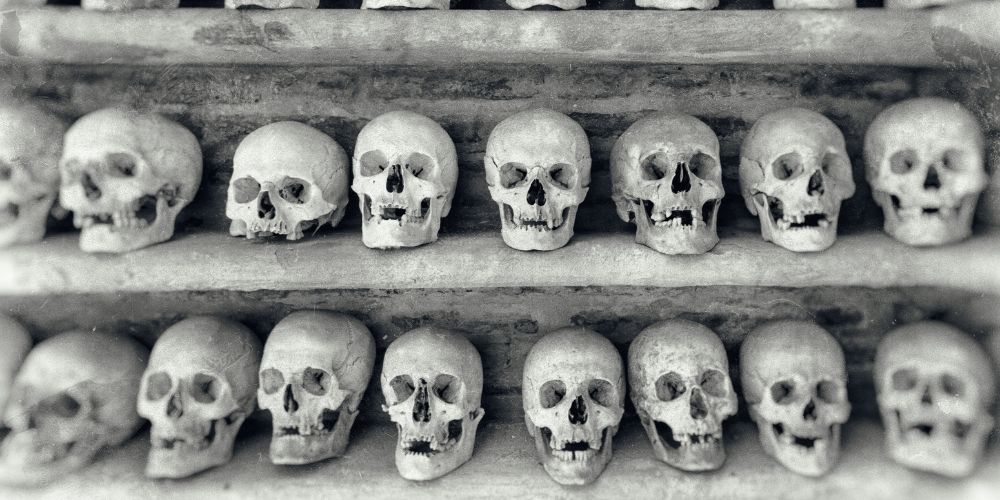
Burial in history, before Monumental Cemeteries.
The practice of burying the dead has its roots in antiquity, and every civilization has developed its own rituals around the mystery of death. Since prehistoric times, humans have buried their loved ones to preserve their memory, giving rise to the first Necropolises. With the advent of Christianity, to escape persecution, burials moved into the Catacombs — underground galleries excavated between the 2nd and 3rd centuries AD — some of which can still be visited today.
During the Middle Ages, it became customary to bury the dead inside churches, close to the relics of saints and martyrs. Social class determined the location of the tombs: clergymen and wealthy individuals were buried beneath the floor, while others rested around the church. It was in this period that symbols — such as the anchor, the dove with an olive branch, or the lamb — and inscriptions began to appear, restoring a personal identity to the deceased.
With Napoleon’s Edict of Saint-Cloud in 1804, burials inside churches were banned and new cemeteries were built outside city walls, giving rise to the modern cemetery. Wealthy cities or those marked by important historical events began to host Monumental Cemeteries — solemn and evocative places created to honor artists, statesmen, and benefactors.
10. The Monumental Cemetery of Milan
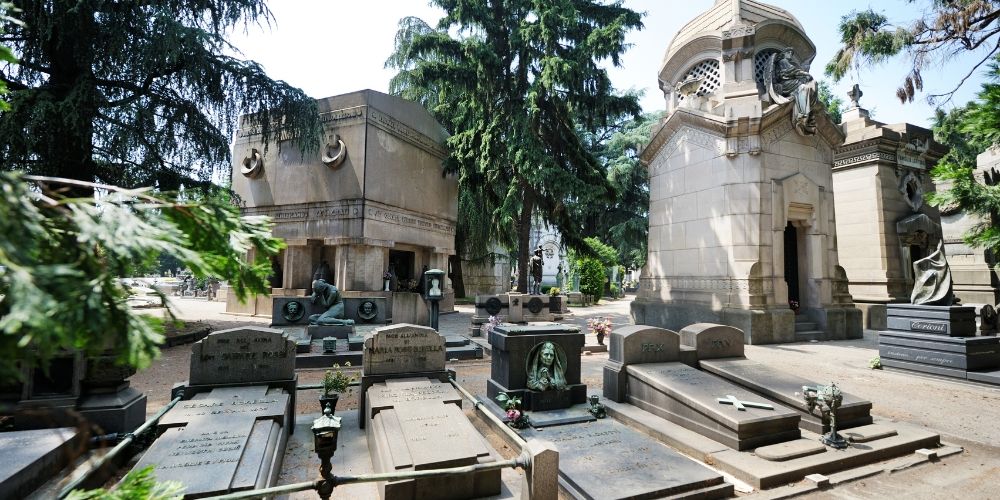
The Monumental Cemetery of Milan
The Monumental Cemetery of Milan was established in 1866 and is among the most important ones in Italy and Europe because of its architecture and the very high artistic value of the sculptures it contains.
At the center of the cemetery's front elevation is the Famedio, or "Temple of Fame", a place for the burial, celebration and remembrance of Milanese, by birth or adoption, who made the city and Italy illustrious: the ‘illustrious’ for literary, artistic, scientific merits or distinguished acts, the ‘well-deserving’ who brought benefits and fame to the city, and the ‘notables in the national history’ who contributed to the country’s development, such as Arturo Toscanini, Giuseppe Verdi, Alessandro Manzoni, Dario Fo, Franca Rame, and Carla Fracci.
The wonderful works of art adorning the tombs are by important artists such as Lucio Fontana, Medardo Rosso, and Giò Pomodoro. The chapels are also true works of art, designed by prominent figures from the Milanese architectural scene, and enriched with fine sculptures and decorative elements.
The Municipality of Milan organizes free guided tours to promote and enhance the Monumental Cemetery, considered an important cultural attraction for its historical significance and the artistic value of the works and figures connected to the history of Milan and of Italy as a whole.
Visit Milan with the Milan City Pass9. The Monumental Cemetery in Staglieno, Genova
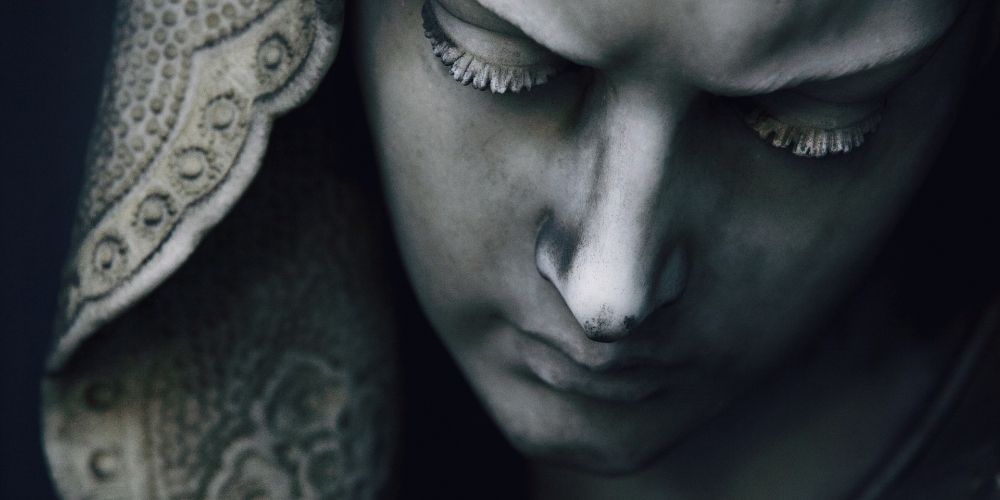
The Monumental Cemetery in Staglieno, Genova
The Monumental Cemetery in Staglieno, Genoa, was officially opened on January 1st, 1851 although it was still unfinished.
Designed by architects Carlo Barabino and Giovanni Battista Resasco, it’s a true open-air museum because of its architecture and large quantity of funerary artworks, so much so that Ernest Hemingway described it as “one of the wonders of the world,” and many historical figures — including Friedrich Nietzsche, Guy de Maupassant, and Mark Twain — wrote about the haunting charm of Staglieno.
The entrance to the Cemetery of Staglieno is flanked by the two statues of Hope and Charity and has a quadrangular structure. Over time, the original design was given a monumental character with the addition of wide porticos decorated by a double row of artistic monuments culminating in the imposing Pantheon, all harmoniously set within the natural surroundings, the Boschetto, where rich family monuments stand.
The marble statues that adorn the tombs of Genoese nobles of the second half of the 19th century were created by important artists, and among the representative figures of history and culture who rest in this magical place are Giuseppe Mazzini, Constance Mary Lloyd wife of Oscar Wilde, and the great singer-songwriter Fabrizio De Andrè.
To delve deeper into the history of the Staglieno Monumental Cemetery, you can join one of its fascinating guided tours.
8. Verano Monumental Cemetery, Rome

Verano Monumental Cemetery, Rome
The Verano Cemetery was built between 1809 and 1812 to a design by Giuseppe Valadier and was consecrated in 1835. The main entrance is made imposing by the presence of four large statues representing Meditation, Hope, Charity and Silence and precedes a large quadriportico, the Carthusian Monastery, which houses private family burials.
Beyond the quadriportico stretch wide fields dotted with crosses, cypresses, and small monuments, whose ensemble creates a picturesque and evocative effect. The tomb monuments in Rome's Monumental Cemetery are characterized by a remarkable variety of styles ranging from Neoclassicism to Realism, from Eclecticism to Symbolism and Futurism, with works executed by the greatest exponents of 19th-century art.
Many prominent personalities are buried within its lofty walls, such as Alberto Sordi, Vittorio De Sica, Alberto Moravia, Trilussa, Giacomo Balla, Vittorio Gassman, Nino Manfredi, Gianni Rodari, Ettore Petrolini, Eduardo De Filippo and many others.
To admire the rich historical and artistic heritage of the Verano Monumental Cemetery, you can book a "Walks among Memories" visit, choosing from a variety of thematic tours such as those dedicated to the Great War, the Italian theater, or the important female figures who lived in the 19th and 20th centuries and now rest in the Roman cemetery.
7. The Non-Catholic Cemetery for Foreigners, Rome
The Non-Catholic Cemetery for Foreigners in Rome is one of the oldest cemeteries in Europe and dates as far back as 1716; it came into being because the church did not allow non-Catholics to be buried within the city walls, which is why it is also called the English or Protestant Cemetery.
Because of the importance of the burials it houses it was declared a Monumental Area of National Interest in 1918. It's an Anglo-Saxon-style cemetery with photo-less headstones and multilingual epitaphs, an enchanted place that instills a sense of peace in its visitors. The Cemetery unites men and women from different countries, languages and professions, and there are many prominent people buried here.
In fact, the Non-Catholic Cemetery of Rome is also called the Artists' and Poets' Cemetery; in fact, personalities such as John Keats and Percy Bysshe Shelley are buried there. Although it is a cemetery that hosts mainly foreign and particularly Anglo-Saxon non-Catholics, there are illustrious exceptions as in the case of Antonio Gramsci, Andrea Camilleri and, last in order of burial, Giorgio Napolitano 11th President of the Italian Republic.
6. Fontanelle Cemetery in the Rione Sanità, Naples
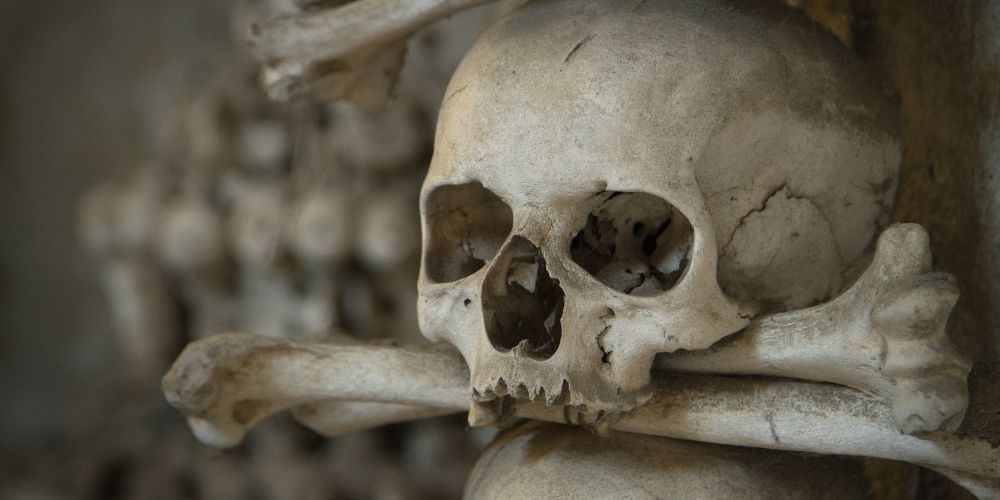
Fontanelle Cemetery in the Rione Sanità, Naples
An altogether peculiar cemetery, currently unfortunately not visitable, is the Fontanelle Cemetery in Naples, which holds the skulls and bones of Neapolitans who could not afford an official burial neatly placed in ancient quarries and crevices carved into the rock.
To this day it is still an object of veneration by Neapolitans and it seems that the ancient ritual of the "pezzentelle souls" is still practiced, meaning that each believer chooses the skull of an abandoned soul, the 'capuzzella' to care for in exchange for a pardon or more simply numbers to play the lotto.
After a long period of closure, the Fontanelle Cemetery will reopen to visitors in December 2025.
5. Santa Maria di Gesù Monumental Cemetery – Palermo
At the foot of Monte Grifone in Palermo, the Santa Maria di Gesù Monumental Cemetery extends alongside the eponymous church, with noble family chapels and monumental tombs that bear witness to the history of Palermo’s aristocratic and bourgeois families.
Founded in the 19th century as an expansion of preexisting burial grounds, the complex features neogothic and neoclassical details alongside Liberty-style architecture. Among the most notable chapels is that of the Florio family, adorned with a sculpture of a lion drinking from a fountain, symbolizing wealth and aristocratic memory.
Strolling along the pathways, among cypresses and carved marble, visitors can fully appreciate the evolution of Palermo’s funerary art between the 19th and 20th centuries, observing how symbols, inscriptions, and decorations reflect the social status and values of the families interred.
4. Vantiniano Monumental Cemetery, Brescia
The Vantiniano Monumental Cemetery is located in Brescia, not far from the historic city center. It is considered Italy’s first true Monumental Cemetery, established at the beginning of the 19th century and designed in accordance with the new sanitary regulations of the Edict of Saint‑Cloud, which called for burials to be moved outside the city walls and cemeteries to be transformed into spaces of civic memory.
The project was entrusted to the young architect Rodolfo Vantini, often called the "architect of cemeteries." He soon created regular avenues, Neoclassical porticoes, a lighthouse tower dominating the scene, and a rigorous layout that symbolically connected the city with the cemetery itself.
Visiting the Vantiniano is like stepping into an open‑air museum, where monumental tombs, 19th‑century and Art Nouveau sculptures, and Neoclassical architecture tell the history of Brescia and its unique relationship between art, urban space, and memory.
3. Monumental Cemetery of Venice – Island of San Michele
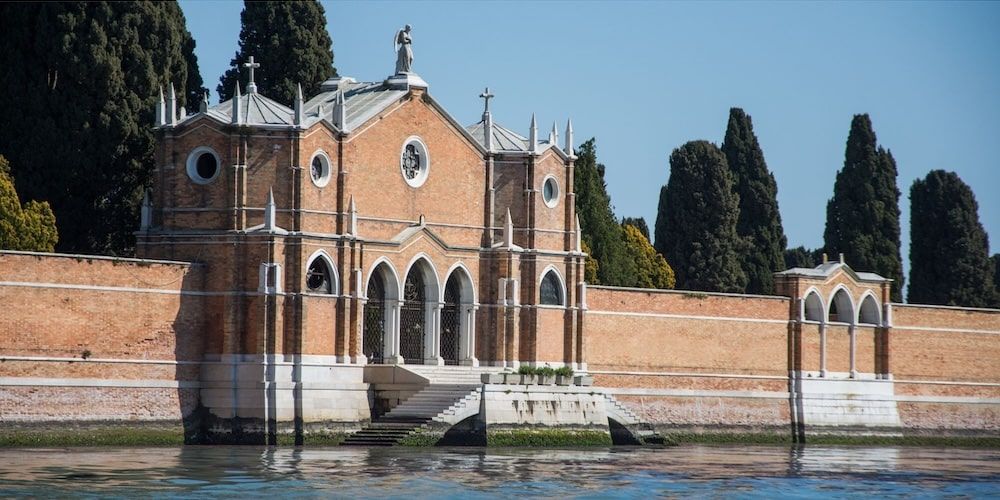
San Michele in Isola Cemetery, Venice
Accessible by vaporetto across the lagoon, the San Michele in Isola Cemetery stands as a true unicum, even for a city as extraordinary as Venice. Founded in 1807 and later expanded to include the nearby island of San Cristoforo della Pace, this cemetery too was established following the Saint-Cloud Edict.
Its architecture spans different eras: from the early Neoclassical structures designed by architect Gianantonio Selva in the early 19th century, to the contemporary expansion by David Chipperfield in 2000, which introduced the Court of the Four Evangelists, the Ossuary Enclosure, and the inner dock.
The cemetery welcomes burials from various faiths — Catholic, Orthodox, Protestant, and Jewish — reflecting Venice’s enduring cultural diversity. Among the notable figures resting here are Ezra Pound and Igor Stravinsky, whose presence lends the island an everlasting aura of international memory.
2. Monumental Cemetery of the Certosa, Bologna

Monumental Cemetery of the Certosa, Bologna
Founded in 1801 on the remains of a former 14th-century Carthusian monastery, the Certosa Cemetery stands just outside Bologna’s ancient city walls. Covering an area of about 30 hectares, it’s now regarded as one of the largest and most artistically significant cemeteries in Italy and Europe, with over two hundred artists contributing over the centuries to its tombs, arcades, cloisters, and galleries.
During the 19th century, it became a celebrated destination for intellectuals and distinguished travelers such as Lord Byron, Charles Dickens, and Sigmund Freud, all captivated by its extraordinary blend of funerary art and architecture.
Among its most fascinating corners is the Chiostro Terzo (Third Cloister), where you can admire rare tempera-painted tombs and delicate stucco and scagliola decorations — an exquisite artistic language once reserved for Bologna’s noble families, before 19th-century tastes turned toward marble and bronze monuments.
1. Cemetery of the Porte Sante – Florence
Just beyond the San Miniato al Monte Abbey, the Cemetery of the Porte Sante opens up like a small world of its own on the outskirts of Florence.
Inaugurated in 1848 and designed by architect Niccolò Matas, it was originally created as an extension of the monastery, but over time it has become far more than a simple burial place. From up here, the view stretches across the entire city, and the silence seems to amplify the beauty of this incredible panorama.
The quiet avenues are dotted with cypress trees and chapels adorned with marble and Liberty-style stained glass, offering a glimpse of the city’s most intimate side and of those who, over the centuries, have been some of its most notable figures, such as Carlo Collodi, Giovanni Spadolini, and Franco Zeffirelli.
More Monumental Cemeteries in Italy
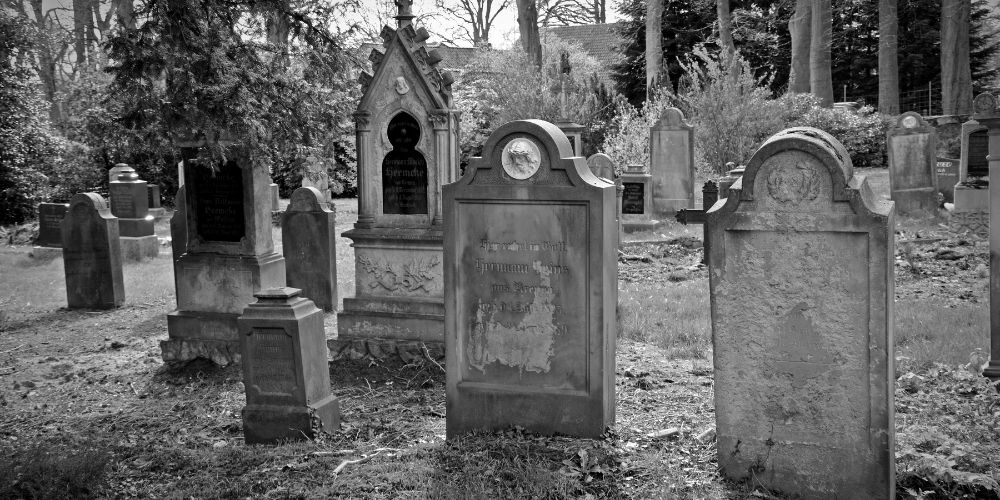
More Monumental Cemeteries in Italy
There are still many Monumental Cemeteries from the North to the South of the peninsula that deserve a visit and where you can admire the burials and chapels beautifully decorated with striking sculptures dedicated to those who rest there. We suggest:
- Monumental Cemetery of Turin: with its more than ten kilometers of porticoed galleries, it features remarkable Liberty and Art Deco works of great artistic value.
- La Cigna Monumental Cemetery, Livorno: also called the Cemetery of 'The Wolves' because it stands on an ancient 3rd-century B.C. necropolis known to this day as "Santo Stefano ai Lupi."
- Fiumicino Cemetery, Isola Sacra: renowned for its proximity to the Roman archaeological area, it preserves an ancient Imperial necropolis and early Christian remains, set within a unique historical and archaeological context.
- Gran Camposanto, Messina: one of the largest and most scenic cemeteries in southern Italy, inaugurated in 1872, it stands out for its panoramic position and its impressive commemorative sculptures.
- Bonaria Cemetery, Cagliari: founded in 1829, it overlooks the sea and houses elegant Neoclassical and Liberty-style sculptures.
About the author
Written on 01/11/2023

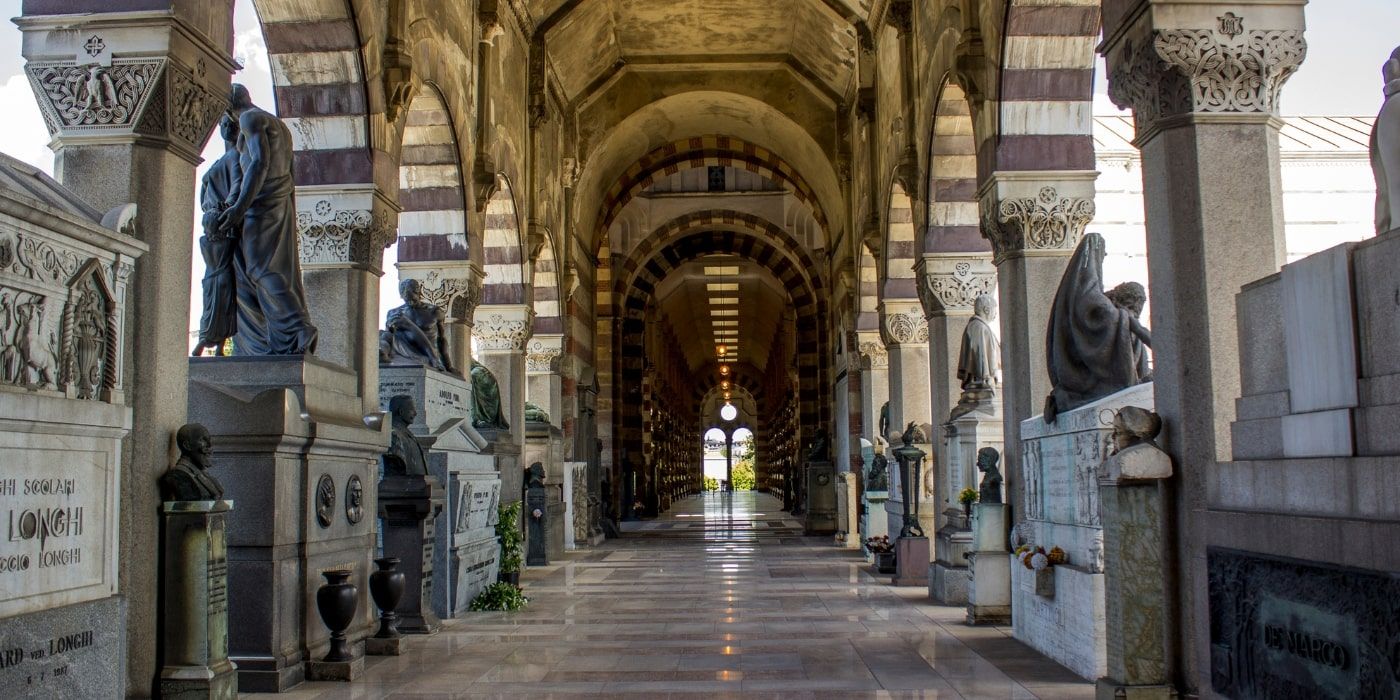
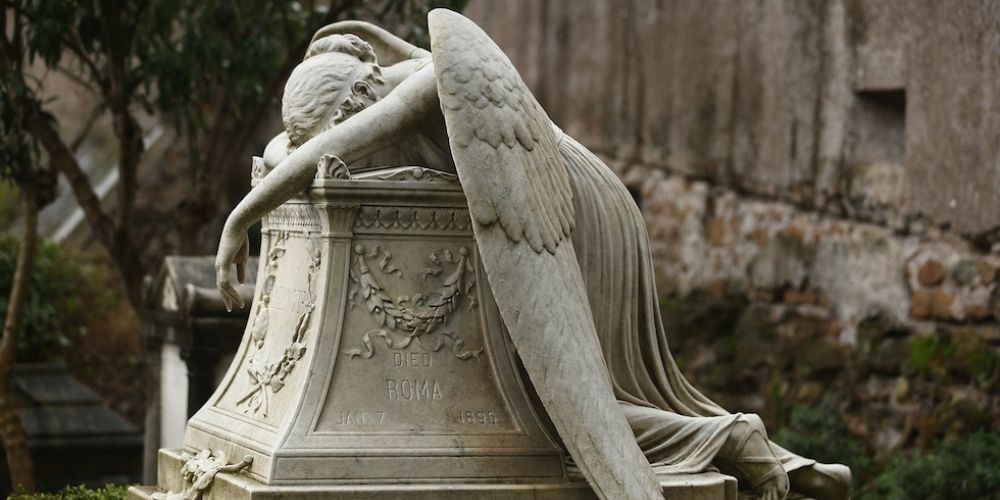

Mariateresa Bonanotte
Places of peace and memory filled with evocative sculptures and impressive chapels, Monumental Cemeteries are open-air museums. Discover them with us!